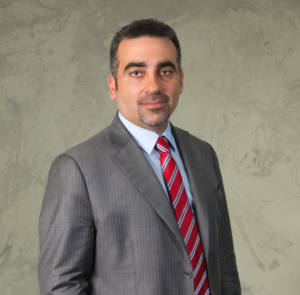Adham Sleiman, VP, Booz Allen Hamilton, MENA, and Rafael Mateo, Senior Associate, Digital Energy, assess the institutional, commercial and technological challenges to the adoption of blockchain technology in the renewable energy space in the GCC region
Dubai, UAE, 5 March 2019: Blockchain as a technology has been around for a while, yet there are institutional, commercial and technological challenges that need to be addressed, said Dr Adham Sleiman, VP, Booz Allen Hamilton, MENA, during a session on ‘Unleashing the power of blockchain in the GCCs race for renewable energy’.

Dr Adham Sleiman, VP, Booz Allen Hamilton, MENA
The session, held on March 3, 2019, was steered towards exploring blockchain and its contribution to the energy space. Sleiman said, “Tomorrow if you and I decide to install a solar panel on the rooftop and pump electricity into the grid, attention must be drawn on how to regulate it.” Pointing to the commercial challenges, he said, “With regard to payments, when people use and manage energy commercially, blockchain will help them get paid for their contribution to the grid.”
“Today, we are moving towards a decentralised grid where consumers and producers are spread across and a utility no longer has complete control over the generation of power,” Sleiman said. He posed a question, “So in what way can blockchain technology make a contribution?” Elaborating, he said: “Blockchain is a technology that allows a distributed database to exist, where records are time-stamped and are linked to each other in a sequence. This is then encrypted, to enable security to allow each party in the chain to access information. So it’s about creating a chain of events and records that are self-producing. The Internet will lead to democratisation and mediation and people will be able to transact from peer-to-peer without having to go to a central authority. At the same time, it is a young technology and is not proven to work.” Sleiman added: “It has issues with scalability because of the requisites linking to each other and as a result, you end up having a very long process. This can severely slow down computational responsiveness of such systems and the reality is, the issues we look at today – as having the potential of being solved by blockchain – might also be solved by standard digital solutions.”
After the generation of renewable energy, Sleiman pointed to tracking the energy being produced as the next major challenge. He said, “If a company wishes to say that they use only Green power sources, how do they prove it?” It is here, he said, where the company can buy energy, which also reflects in the blockchain that the use of Smart Contracts comes into play.

Rafael Mateo, Senior Associate, Digital Energy
Once the conditions have been agreed upon, the blockchain will automatically establish the contract, Sleiman said. Giving one example of where blockchain has been put into practice, Sleiman added, “ACWA Power in Saudi Arabia has already established one of the most standardised solutions for tracking energy by using the solar coin.” Elaborating on how it works, Rafael Mateo, Senior Associate, Digital Energy, said: “If I am a solar energy producer, I can ask the solar coin foundation to give me solar coins and then I can buy products or services from businesses that accept solar coins. We’ve seen a lot of utilities implement this and DEWA also is experimenting with blockchain for smart contracts for electric vehicle charging.” In the end, the smart contract is the last building block that makes blockchain applicable, he added.
Elaborating on how utilities must respond to the technology, Mateo said, “If we look at the telecom industry during the 2000s, they were heavily invested in communication and the actual infrastructure part.” They had a choice to make because the users had to use content and had to be channel players, he said. Elaborating, he said, “They had to go in and get a piece of the action and make end-users pay for digital content.”
Sleiman said, “Blockchain is just one of the many technologies out there and companies must gauge the extent to which it can make operations more efficient.” Another aspect, he said, is understanding and having a clear direction of the potential benefits that blockchain can bring. “Blockchain,” he added, “must solve the real business need and when it comes to implementation, Proof of Concepts (POC) must be created.”
Copyright © 2006-2025 - CPI Industry. All rights reserved.